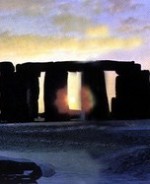 The winter solstice isn’t just for gardeners, of course, but it does have special significance for their plants. The day of the winter solstice is the shortest day and longest night of the year so plants get a minimum of light. On the other hand, it is also the end of the gradual shortening of days, and the beginning of the gradual lengthening of days, so by June the plants can revel in 12 hours or more of daylight, 24 hours if they grow in Alaska. After 6 months of declining daylight our plants should be jumping up and down with excitement, or at least shaking their leaves with anticipation.
The winter solstice isn’t just for gardeners, of course, but it does have special significance for their plants. The day of the winter solstice is the shortest day and longest night of the year so plants get a minimum of light. On the other hand, it is also the end of the gradual shortening of days, and the beginning of the gradual lengthening of days, so by June the plants can revel in 12 hours or more of daylight, 24 hours if they grow in Alaska. After 6 months of declining daylight our plants should be jumping up and down with excitement, or at least shaking their leaves with anticipation.
The winter solstice is a result of the tilt of the earth in relationship to the sun. It occurs in the Northern Hemisphere when the earth’s tilt causes the North Pole to be the maximum distance from the sun. At this time, the sun’s elevation in the sky is the lowest and so the day length is the least, that is, the day is the shortest of the year.
In summer, another solstice occurs June. In the Northern Hemisphere it has the longest day of the year and marks the moment when the days begin to shorten. In the Southern Hemisphere the solstices are reversed.
The word solstice comes from two Latin words, sol (sun) and sistere (stand still) so literally means, ”the sun stands still”. This refers to the fact that the sun’s apparent north-south movement appears to stop as it reverses direction. The solstice, therefore, is actually a moment, not a whole day. In 2011, the winter solstice will occur at 05:30 UTC (Coordinated Universal time) on December 22.
In 2012, the winter solstice will occur on December 21. Yes, the solstice is not on one specific date. It can occur on December 20 to December 23 depending on the year in the Gregorian calendar. Most solstices occur on December 21 or 22; you will have to wait until 2080 for one occurring on December 20, and 2303 for one occurring on December 23. According to the calendar of Julius Caesar in 46 BC, the winter solstice was December 25 (the Gregorian calendar shifted it forward a few days).
Because the solstice refers to a reversal in the direction of the sun’s apparent movement and the reversal of the progression from short days to longer ones, many cultures have associated reversals of other sorts with the solstice. Dating perhaps to Neolithic times, the celebration of the birth or rebirth of sun gods at the time of the solstices has been one of the common themes among peoples of Asia, the Americas, and Europe.
What about your plants? By the time the winter solstice arrives they have probably slowed their growth and perhaps started dormancy. Many plants need a rest from their vigorous growth during the rest of the year so do not need fertilizer during this time. They will slowly revive as the days lengthen and they receive more light and that is the signal to begin a fertilizing regime.
